by Winding Pathways | Aug 11, 2022 | (Sub)Urban Homesteading, Bugs, Garden/Yard, Garden/Yard, Nature
Imagine how embarrassing it would be to be caught stark naked in public. Maybe that’s how the Walking Stick, a huge insect, felt that we spotted clinging to a shelf outside our house.
About 3000 species of Walking Sticks live worldwide. All love hiding. Their camouflage is almost perfect. No doubt the one we discovered would have been far more comfortable clinging nearly invisible on tree bark.
Although common and huge some species can be upwards of 20 inches long! They’re nearly impossible to spot as they lurk on twigs and bark. We likely walk right by many. They simply hide in plain sight. The name of their order is Phasmatodea, meaning apparition. It perfectly describes them.
The one we spotted must have been lost. Rather than comfortably blending into the woods our gangly stick-looking insect contrasted against our shelf as naked as a jaybird. We couldn’t miss spotting it.
Herbivorous Walking Sticks spend nights munching on leaves and rest during daylight. Females are usually bigger than males and usually just drop their eggs to the ground. Growth is slow, and the babies can take three to 12 months to mature. That’s glacial growth for an insect, but they can live for two years if not devoured by birds, small mammals, or predatory insects. Insecticides devastate them.
Walking Sticks don’t bite or sting and are one of the thousands of nature’s wonders to discover in an ecologically healthy yard. They’re downright fascinating and fun to share with children.
-

-
Easy to see
-
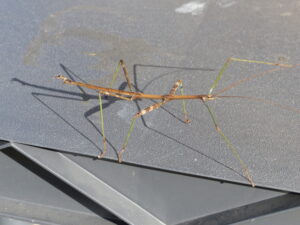
-
A large herbivore.
-
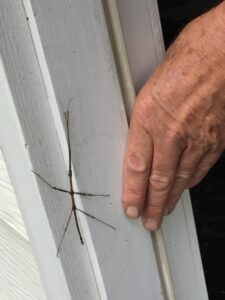
-
Walking Sticks are easy to spot on plain backgrounds.
by Winding Pathways | Jul 14, 2022 | Garden/Yard, Garden/Yard
Gardeners across the world proudly bring freshly picked vegetables and fruits into the kitchen. They’re lucky to have an amazing array of delicious plants to grow and enjoy. It wasn’t always that way.
Consider Native Americans. Prior to Columbus, many lived in cities and big towns surrounded by gardens and farm fields. They grew corn, beans, and a diversity of squash and pumpkins, but they knew nothing of many of today’s common vegetables. Residents of Asia, Africa, Europe, and Australia back then also farmed and gardened, but their crop choices were limited.
-

-
Many foods were cultivated by indigenous people.
-

-
Cahokia Mound
New World & Old World

Indigenous contacts ranged far and wide.
It changed quickly following what’s called the Great Columbian Exchange. Shortly after Columbus set foot on Hispaniola people began deliberately and purposefully moving plants and animals around the world. Many were valuable and diversified the food chain on all continents. Others quickly became pests………most weeds infesting American gardens originated in the Old World.
Imagine Southern Italian cuisine without tomatoes! This delicious vegetable originated in South America and was unknown in Italy before the Columbian Exchange. Same with potatoes. The Irish potato originated in South America.
It went both ways. Today’s gardeners enjoy vegetables originating all over the globe. Here’s a brief list of where common foods came from:
NATIVE OF THE NEW WORLD
Pumpkins and squash, Beans except for fava, Corn, Potato, Sweet Potato, Tomato, Pepper, Jicama
-

-
A machete is useful in cutting squash.
-

-
The sweetness of summer’s bounty.
-

-
Sweet potatoes are a healthy vegetable.
NATIVE OF EUROPE, ASIA, and AFRICA
Watermelons and cantaloupes, Onions, leeks, and garlic, Turnips, Carrots and parsnips, Yams, Radish, Celery, Asparagus, Beets, and Chard, are the same species, Cabbage, Cauliflower, Brussel Sprouts, Broccoli – all related, Endive, Lettuce, Rhubarb, Spinach, Okra, Cucumber, Peas.
The Columbian exchange also included grains and fruit. Corn is American but wheat, barley, rye, and oats are from the Old World. Apples, peaches, pears, and cherries (except for the bitter American black cherry) are also Old World. Brambles and strawberries apparently lived in both the Old and New Worlds prior to Columbus. Grapes eaten fresh and used for juice and wine came from the Old World but several species also are native to the Americas.
-
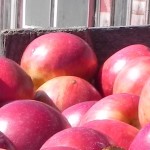
-
A favorite fall harvest is apples.
-

-
Tart cherries come ripe in June.
Thanks to the movement of useful plants gardeners worldwide enjoy a diversity of plants to grow and eat.
by Winding Pathways | Jun 30, 2022 | (Sub)Urban Homesteading, Garden/Yard, Garden/Yard
Varied Garden Produce
Midsummer. It’s the heart of gardening season as millions of Americans proudly bring tomatoes, beans, squash, and a host of other crops into the kitchen from the backyard garden.
Many don’t realize they ignore eating a typical garden’s hidden delightful food.
Most gardeners spend hours pulling and hoeing incredibly common and prolific garden weeds, only to toss them out. They make delicious food.
Here are our favorite “weeds” to eat
Lambsquarters. The young leaves of this persistent and fast-growing plant are delicious in salads. Or they can be boiled and used like spinach.
Amaranth or Pigweed. Sometimes called wild beet. Almost as common as lambs quarters, the young leaves can also be used similarly to spinach.
Purslane. This ground-hugging hot weather weed is a commercial crop in India. Young leaves and stems are delicious raw. They can also be boiled or even pickled. Grit tends to cling to purslane so rinse it thoroughly.
-

-
A full pot of raw Lamb’s Quarters cooks down to a few fork fulls of this nutritious potherb.
-

-
The Latin name is Portulaca oleracea
Crops with Rarely Harvested Edible Parts
Our favorites are
Beet greens. Beets are the same species as Swiss chard but the leaves tend to toughen as the plant grows. We use young beet leaves as we would chard.
Sweet Potato leaves. We haven’t tried these yet but will this summer. From what we’ve read they are delicious steamed and can be eaten raw.
Squash and pumpkin blooms. These plants usually produce more blooms than they need. We sparingly pick and steam them for a colorful yellow vegetable.
Carrot tops. Our master gardener friend thins carrots and uses the tops in pesto. We tried this in a pesto that a friend shared. Delicious!
Radish tops. Mix a few young leaves into salads. They’re spicy and add zest to other greens.
-
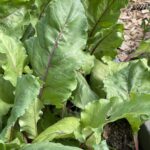
-
Beets are a cousin to Swiss Chard
-

-
Sautee or mix in a salad
-

-
Add to pesto!
-

Resources
Whenever eating a new plant for the first time, make sure the identification is correct. It’s smart to identify a wild plant from at least three sources. These might include an Internet search, a wild foods book, or identification by a trusted wild food or garden expert. One online source is www.wildedible.com. Once you’re certain it’s edible, eat a small helping the first time to make sure you like it and it likes you.
by Winding Pathways | May 26, 2022 | (Sub)Urban Homesteading, Garden/Yard, Garden/Yard, Preparedness
Good Friday Tradition
On a cold April morning, we planted a row of potatoes at Winding Pathways. This plant has made an amazing long journey to reach our yard.
Potatoes are native to South and Central America and were cultivated by native people long before Columbus. Early Spanish explorers realized this humble American plant produces an enormous amount of food that’s easy to store. They brought potato sets back to Spain, and eventually, the plant was cultivated throughout Europe.
-

-
Sweet potatoes are a healthy vegetable.
-

-
Potatoes are hardy and plentiful.
Productive Crop
Potatoes produce more human food per square foot than wheat, rice, corn, or nearly any other crop, so crowded Ireland embraced the plant. Potatoes thrived in Irish soil and were so productive they enabled the human population to flourish. Unfortunately, the entire crop was of just one or two varieties. Disaster hit. Between 1855 and 1859 blight killed most of the crop, which lacked resistance to the disease. It caused massive starvation and spurred huge immigration to the United States.
Early Europeans who colonized North America brought potatoes to plant in the New World. So, an American plant crossed the Atlantic Ocean twice in its long journey.
Vandals and Hawkeyes
We both hold degrees from the University of Idaho. It’s the potato state, and the plant loves the light volcanic soil along the Snake River in the southern part of the state. Iowa, where we live, is the corn state, but humble potatoes do well in our garden.
We buy seed potatoes in early spring, cut and cure them, and plant them in early April. They don’t expect much from us, and by mid-summer we carefully hand dig delicious new potatoes. Later, when the tops die back, we dig and cure a bushel, or so, for winter storage.
Expert Resource at Hand
We hedge our bets by planting a few potato varieties, and this year we’re fortunate to have a potato expert move to Cedar Rapids. Jean Contina earned his doctorate degree from the University of Idaho studying potato diseases. He’s a fellow Vandal! We’ll seek his advice on how to maximize our crop.
-

-
Chickens don’t seem to bother the potatoes.
-

-
Beautifully presented dinner.
Inexpensive. Why Grow Them?
Store-bought potatoes are one of the least expensive foods. So why grow them?
We have two reasons. First, anything we grow seems more delicious than its store-bought counterpart. It may be our imagination but it is true. Second, they are an easy crop to grow and store well all winter without the need to can or freeze them. Having potatoes stored in a cool dark room in our house gives us a bit of food security in a crazy world.
by Winding Pathways | Apr 28, 2022 | (Sub)Urban Homesteading, Chickens, Foraging, Garden/Yard, Garden/Yard, Weeds
We are shocked by the rise of many prices, especially food. Fortunately, we mute the cost by finding or growing groceries here at Winding Pathways. We’re lucky to own two acres, but folks living on tiny lots can produce an amazing amount of food, even if they aren’t passionate gardeners.
In a nutshell here’s what we do to tame grocery bills:
Foraging
It’s ironic that many people consider the most delicious and easy wild foods pests and spend time and money trying to eliminate them. We eat ‘em. Books and websites, including Winding Pathways, share tips on finding, identifying, harvesting, cooking, and eating wild foods. Caveat: ALWAYS check that you have the correct plant, gather from unpolluted places, and consume only a small amount initially to be sure your body accepts the wild edible.
Here are our favorites:
Gardening
We’re not passionate gardeners and we don’t can or freeze vegetables, so here’s what we do:
- Succession plant: Our small garden yields an enormous amount of food. We don’t let a square foot be idle. When summer’s heat turns lettuce bitter, we pull it, feed it to our chickens, and plant beans or another heat-loving crop. Same with other crops that grow quickly and then fade.
- Use vertical space: Pole beans, for example, produce much more food per square foot than bush beans, so we choose climbers and use vertical space. We have the pole high enough to reach up and pull off the beans.
- Grow dwarfs: Some cucumber varieties, for example, are “bush” type, meaning they produce a crop without long vines that consume plenty of space.
- Think of winter eating: Because we lack freezer space and don’t can food, we plant vegetables that need little care during the growing season and store them until late winter without being canned or frozen. Here’s our list:
-
- Winter squash. Pick them, let them curet, and store them in a cool spot. They keep for months. Same with pie pumpkins.
- Carrots and parsnips. In late fall we smother the plants with a thick blanket of dry leaves or straw that keeps the ground from freezing. We’ve harvested carrots in January by brushing away snow and peeling back the mulch and pulling them.
- Sweet potatoes. They love the South’s climate yet grow well up north.
We carefully dig them in the fall, cure them, and store them like winter squash.
-

-
Sweet potatoes are a healthy vegetable.
-

-
Winter Squash vary in color, texture, shape and size.
Chickens
We can’t imagine living without a small chicken flock. Our six to 12 hens gift us a couple of dozen eggs a week. Their manure fertilizes the garden and garden weeds are a great hen chow. During warm months our hens forage in their large run eating bugs, worms, and weeds and transforming them into eggs. Sometimes we even stew down an old hen.
-

-
In the summer hens find plenty to eat.
-
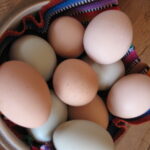
-
The chickens kept on laying eggs.
-

-
Chickens efficiently recycle squash seeds to eggs.
Wildlife
Lots of folks don’t like hunting. For us harvesting a deer is a form of food gathering, not recreation. After all, deer are free-ranging, local, and organic. Fortunately, we’re able to hunt on our property and convert a deer into delicious meat. We also enjoy eating panfish.
Like most folks, we can’t grow or forage all our food but much comes from the yard and area. It takes knowledge and investment in elbow grease but trims the food budget. Perhaps even better, knowing how to find and grow food makes us feel less vulnerable to national disruptions that make food either hard to get or expensive.
by Winding Pathways | Mar 17, 2022 | (Sub)Urban Homesteading, Garden/Yard, Garden/Yard
As we watched squirrels gleaning sunflower seeds from feeders in our backyard, we dined on 2021s sunshine!

Sweet potatoes are a healthy vegetable.
Thanks to last season’s sun our crop of sweet potatoes produced a bountiful crop, and we ate them until our last one became part of our February 8th dinner. We’ve only been growing sweet potatoes for a few years because we’d heard they need a long southern summer to mature. We now know that’s not true.
We love sweet potatoes. They come in many varieties and color shades from white to purple and the common ones with deep orange flesh. This nutritious plant originated from tropical South America and is now grown in warm regions all over the world. Sometimes they are called yams, but these two plants are distinctly different. Yams originated in Africa.
Nutritious Vegetable
We love the taste and nutrition of sweet potatoes but here are some other ways we love this plant:
- They are easy to grow. We buy “slips” and plant them in late May or early June.
- The plants and flowers are gorgeous, and slips are sometimes sold as ornamentals.
- They store well. We carefully dig them before the first frost, let them cure for a couple of weeks, and then store them in a cool dark place. They last all winter.
Sweet potatoes are easy. No freezing or canning is needed. We plant, weed a bit, dig, cure, and store and then enjoy eating them all winter. This year we’ve ordered a variety of sweet potato slips from Sand Hill Preservation Center and look forward to a larger harvest. The company also sells heritage chicken breeds and vegetable seeds.




























